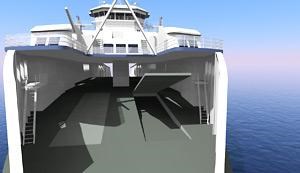Plans for the Queen of Burnaby’s replacement are complete and representatives from BC Ferries were in town Tuesday, December 9, to present the plans and answer questions from the public.
Darin Guenette, public affairs manager for the ferry corporation, said that of the three intermediate class ships to be built, the first one completed, slated for fall 2016, will replace the aging ship on the Powell River - Comox route.
“It’s an exciting time for Powell River,” said Guenette at the public information session at Powell River Town Centre Hotel. He was joined by colleagues Mark Wilson, vice-president of engineering, and Corrine Storey, vice-president of customer service.
Three ships are being built to replace the Queen of Burnaby and the Queen of Nanaimo, which services a southern Gulf Islands route. The additional ship will be used as a replacement during servicing of vessels.
Each of the three intermediate class ferries will have a vehicle capacity for between 145 to 150 cars and seating for 476 passengers: 160 at cafe-style tables, 305 in lounge seating and 11 available in carrels for business users.
The vessels are being built with the dual fuel capability of operating on both liquefied natural gas and marine diesel.
There will be room for 85 cars on the main deck and 65 on the lower deck.
Guenette said this size meets BC Ferries’ requirements and matches the Queen of Burnaby’s effective capacity for vehicles.
He explained that in undertaking the replacement project the ferry corporation hired a consulting firm to perform demographic analysis and forecasting. It determined that even with a population growth of 1.2 per cent over the next 20 years, riders would face overloads on only three per cent of total trips throughout the year, Guenette said.
He added that if higher growth rates happen in Powell River the plan would be to bring a larger vessel to the route which could handle the increased traffic.
“That’s why we’re not naming our vessels after places anymore,” he said. Guenette said BC Ferries has not yet arrived at the point in the project when it will select names for the three vessels.
He said it is looking for some fine tuning on customer amenities and accommodation design, on the number of seats that are facing each other, the layout in general of the lounges and whether the public likes the mix between carpet and vinyl flooring.
It is also curious about specific concerns that were expressed by the public the last time BC Ferries had a public consultation on the vessels and were incorporated into the shipyard designs, specifically around accessible washroom stalls in the ships’ bathrooms. Currently, there is only one washroom for people with disabilities on the passenger deck and one each on the car decks. Other bathrooms have only regular-sized stalls.
“The question we had was: what do people think about putting accessible stalls in the main bathrooms at the cost of losing one regular-sized stall?” he said. “For us these are changes we can make that really don’t change the cost of the project.”
The plans call for 40 electrical outlets throughout the seating areas. “We know from experience that people rush to the outlets—everybody’s got something to plug in,” he said.
Traditionally, a ship’s available outlets have been along the outer bulkhead, but Guenette said BC Ferries is looking for some input on the fine tuning of where to put those outlets.
One design aspect that the ferry corporation heard much concern about was the replacement vessel’s open car deck design. The new design includes large visors which come down at the end of the ship. “It looks like a closed-end vessel, but it’s not,” said Guenette, adding that the design brings the necessary cost savings.
“We’re pretty proud of the design, and we think that we’ve addressed a lot of those issues,” he said.
Guenette said there are a couple of months before BC Ferries has to finalize the accommodation and amenities details. Readers who wish to provide feedback can do so before January 15, 2015, by taking a look at the schematics and then sending an email using the provided feedback form to [email protected].



